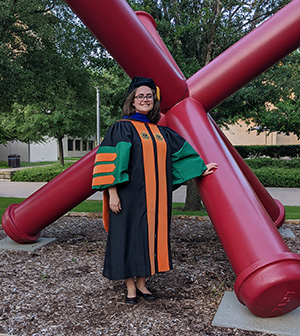
Computational mathematician Georgia Stuart BS’12, MATs’14, PhD’20 is one of the rare scholars who received all her degrees – bachelor’s, two master’s and a doctorate – from UT Dallas.
According to the Office of Statistics, Planning and Analysis, only 10 students in the university’s history have graduated with the same order and number of degrees from UT Dallas.
But Stuart is not done with the University yet – she recently took a job with the Office of Information Technology.
“I’m thrilled to be back – I love UT Dallas. I’m glad to be able to give back to the university community by helping grow the research computing program, where I get to put my UT Dallas math PhD to use every day,” Stuart said. “Math is particularly flexible, and my math background enables me to understand problems quickly in other fields from the computational standpoint.”
Stuart first connected with UT Dallas as a transfer student her junior year. She aspired to be a high school math teacher, so she joined the UTeach Dallas program in the Department of Science/Mathematics Education. The program allows students to earn their undergraduate STEM degree and teacher certification at the same time.
Stuart then enrolled in the department’s Master of Arts in Teaching program where she earned her science education MAT with a concentration in physics as well as her math education MAT.
In addition to her studies, Stuart advocated for increased participation of young women in science and mathematics through her volunteer work with STEM-focused activities for Girl Scouts and as director of the Women in Physics summer camps at UTD.
The more math courses she took, the more she fell in love with higher mathematics, a passion that solidified during a summer of research with Dr. Susan Minkoff, professor of mathematical sciences and an affiliated faculty member in the Department of Geosciences and in Department of Science/Mathematics Education. Minkoff went on to be Stuart’s PhD advisor.
For her postdoctoral studies, Stuart spent a year doing oil-spill research with Dr. Clint Dawson at the Oden Institute for Computational Engineering and Sciences at UT Austin.
“A lot of times when we have oil spills, it’s unclear exactly where they originated from. The idea here is to take satellite imagery of oil spills and figure out where they came from. It’s still the same area of math, and it’s still an inversion problem where you’re given data,” she said.
Stuart’s research focused on the 2010 Deepwater Horizon disaster in the Gulf of Mexico, considered the largest marine oil spill in the history of the petroleum industry.
“We are trying to validate oil spill inversion on the Deepwater Horizon oil spill because we know exactly where that oil spill originated from. It was well documented, and we have some satellite imagery of the oil spill. We are using that to help validate our new techniques,” Stuart said.

“With seismic measures, it’s impossible to truly know the answer to what’s below the surface because every model relies on techniques like full waveform inversion or other techniques in seismic inversion. What we do is create what’s called a synthetic problem, which means you make up the subsurface. You just create it on the computer to generate your observed data, and then try to recover that model from the data,” she said.
Late last fall, she returned to her alma mater to join OIT’s Department of Cyberinfrastructure and Research Support Operations as a research scientist. She now spends more time working on other people’s research computing problems and less time working on her own projects.
“I’ve always loved the high-performance computing, research computing and programming aspects of my work,” Stuart said.
She supports the campus research community by providing guidance and training for using UTD’s high-performance computing (HPC) clusters. She also works with principal investigators on longer-term research projects where significant computational or research computing support is needed, primarily in the School of Behavioral and Brain Sciences on computational neuroscience problems.
Stuart continues to use her computational mathematics expertise on seismic research with Minkoff and Dr. Luis Felipe Pereira, professor of mathematical sciences. She is also interested in computational science workflow research, in particular reproducibility in computational science and automation.
Stuart said she has enjoyed her time at UT Dallas and appreciates the bond established with her alma mater.
“At UTD, I found a lot of support that I don’t know I would’ve gotten at another university. I think that really speaks to the community that UT Dallas is and the types of people who work here. I really love my time at UTD,” she said.
Stories for the newsletter, Math Matters, are produced by faculty and staff of the Department of Mathematical Sciences.
Help us leave the planet a better place for future generations. Your support for the School of Natural Sciences and Mathematics funds scientific discoveries with real-world applications, student and faculty recruitment, and academic scholarships.